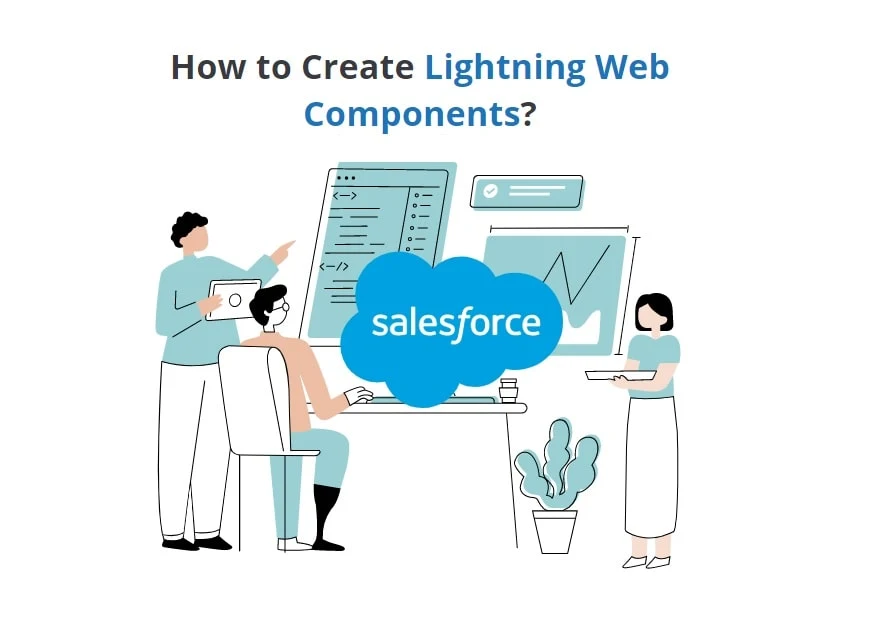
In this world of users, We empower them to be more productive by putting the appropriate information at the right location at the proper moment. Since the release of Summer 21, it is possible to activate an individual Lightning Web Component from a record page by using Quick Actions!
Today, we'll give an in-depth overview of various types of Lightning Web Component actions, provide a quick guideline on the best time to use the action, and end with step-by-step implementation.
Let’s define the Lightning Element
The Salesforce lightning component is synonymous with Aura Component. It is basically a user-interface-dependent framework that aid developers in creating single-page web-based/ desktop/ mobile applications.
Benefits of using Lightning Components
It is used to develop applications using the standardized JavaScript framework.
Components are easy to work with and reusable and flexible, providing a strong and efficient framework for application
VfPages is a counterpart of Salesforce, which has been used for years, but lightning components come into play with better efficiency.
Easy to build an app or page that responds using Lightning Component.
Reason- why has Salesforce launched lightning web components?
Following the announcement that Google has added Web Components to the Chrome browser, all major web browsers like Firefox, Safari, and Edge have begun to implement the technology faster. Salesforce Development had to keep up with the speed and standardization of Web Components in line with the massive demand for internet Components all over the web.
Lightning Web Components use its Web Components technology and the DOM rendering for an unparalleled experience for users on the pages.
The Types of LWC Actions
When it comes to recording pages with Lightning Web Components, there are two kinds Screen Quick Actions and headless quick actions.
Screen Quick Action
They allow users to make updates through a modal window, such as entering a form in order to create or edit the record.
Headless Quick Action
They allow you to perform an action without having to display it, like the ability to navigate to a different page or send an event.
Utilization Case
Danielle, an extremely knowledgeable & outstanding Director of Sales, reported that when it comes time to update deals, she wants to ensure that her sales team is focused on updating key fields to help them win more deals! The team currently utilizes an Edit button; however, she prefers a smaller and more consolidated view.
Let's find out how we can accomplish this using LWC Quick Action. LWC Quick Action.
Here's a brief overview of our modifications to the LWC:
After talking to Danielle, "Amount," "Next Steps," "Amount," "Next Steps," and "Stage" are the three most important fields that our team is continuously updating, so we will add them as inputs. We can include "Opportunity Name" as an output in order to make it more visual.
Definition of the term "Lighting" Web Component to be used for the purpose of a Quick Action.
To utilize the Lightning web component to be a Quick Action, we need to define the metadata of the element.
Create LWC Component in step-by-step Ways
Contrary to Aura, building an LWC component using the Developer console is impossible. It means you'll need a tool for this, and VsCode is the best option because it's cost-free and quick.
Step 1.
Open Visual Studio Code.
Click Command, Shift and Pon macOS or Ctrl + Shift + P on Windows or Linux and enter to create a project.
Then click on "SFDX create a project with manifest" and press the enter button.
Next, choose a standard project, enter your project name, and press the enter button.
Step 2:
Within Visual Studio Code, to access the code, Press Command and Shift plus P for macOS and Ctrl+Shift + P when using Windows or Linux and press SFDX to authorize a Dev Hub.
Choose the Org kind, and then VsCode opens a tab in the browser. You'll need to log in to your org with your org credentials.
After logging in, click Allow.
Once you have authenticated in this browser, it will remember the Org credentials. The message of success will appear like this
Step 3:
You need to open the visual studio code by pressing the particular command "Shift+P” on macOS or Ctrl+ Shift+P:
Enter SFDX ** and then select the option to create a Lightning Web Component, select the name you would like to assign to your lightning web component, then press Enter twice.
This will generate the necessary documents for your initial Lightning web component.
Step 4:
It is the final deployment step. Here you need to install the LWC components to access the org. Here you need to press right-click on the LWC component and select "Deploy source to your org". The process may seem easy to you through this content but practical implementation requires expert-level guidance. For that, we would suggest you collaborate with a web development company for an assured outcome.












0 Comments